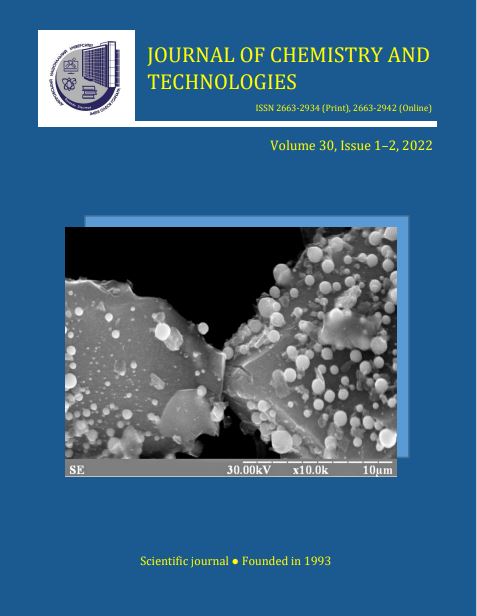Іn-silico STUDY OF ANTHRAQUINONE DERIVATIVES AS PROBABLE INHIBITORS OF COVID-19
DOI:
https://doi.org/10.15421/jchemtech.v30i2.244728Keywords:
Аnthraquinones, triazene, molecular docking, RNA polymerase, protease Covid-19.Abstract
Five previously known anthraquinones with amino derivatives and synthesized new triazene (1-[(1E)-3,3-bis(2-hydroxyethyl)triaz-1-en-1-ol]-4-[(2-hydroxyethyl)amino]anthracene-9,10-dione) were evaluated in-silico as inhibitors of COVID-19 main protease. Preliminary screening has shown that the presence of a sulfo group in the second position of the anthraquinone ring reduces activity, probably due to the inability of the molecule to cross the hydrophilic-lipophilic barrier. Therefore, the desulfation reaction of 4-substituted anthraquinone was carried out and triazene was synthesized on its basis, which due to the presence of a triazene bridge showed good activity. The structures of the synthesized compound were confirmed by IR, 1H, 13C NMR, and LC-MS spectral studies. Chemo-informatics study showed that the compound obeyed the Lipinski's rule. Computational docking analysis was performed using PyRx, AutoDock Vina option based on scoring functions. In-silico molecular docking study results demonstrated Greater binding energy and affinity to the active pocket the N3 binding site of the Coronavirus primary protease.
References
Zhu, N., Zhang, D., Wang, W., Li, X., Yang, B., Song, J., Zhao, X., Huang, B., Shi, W., Lu, R., Niu, P., Zhan, F., Ma, X., Wang, D., Xu, W., Wu, G., Gao, G. F., Tan W. A. (2019). Novel coronavirus from patients with pneumonia in China, N. Engl. J. Med., 382(8), 727–733. doi: 10.1056/NEJMoa2001017
Wu, A., Peng, Y., Huang, B., Ding, X., Wang, X., Niu, P., Meng, J., Zhu, Z., Zhang, Wang, Z., Sheng, J., Quan, J. L., Xia, Z., Tan, W., Cheng, G., Jiang T. (2020). Genome Composition and Divergence of the novel coronavirus (2019-nCoV) originating in China, Cell Host. Microbe., 27(3), 325–328.
https://doi.org/10.1016/j.chom.2020.02.001
Fehr, A. R., Perlman, S. (2015). Coronaviruses: An overview of their replication and pathogenesis, Methods. Mol. Biol., 1282, 1–23. https://doi.org/10.1007/978-1-4939-2438-7_1
Jamkhande, P. G., Pathan, S. K., Wadher, S. J. (2016). In silico PASS analysis and determination of antimycobacterial, antifungal, and antioxidant efficacies of maslinic acid in an extract rich in pentacyclic triterpenoids, Int. J. Mycobacteriol., 5, 417–25. https://doi.org/10.1016/j.ijmyco.2016.06.020
Malik, E., Muller, C. (2016). Anthraquinones as pharmacological tools and drugs., Med. Res. Rev., 36, 705. https://doi.org/10.1002/med.21391
Hussain, H., Al-Harrasi, A., Al-Rawahi, A., Green, I., Csuk, R., Ahmed, I., Shan, A., Abbas, G., Rehman, N., Ullah, R. (2015). A fruitful decade from 2005 to 2014 for anthraquinone patents. Expert Opin. Ther. Pat., 25, 1053.https://doi.org/10.1517/13543776.2015.1050793
Khanal, P., Patil, B.M., Chand, J., Naaz, Y. (2020). Anthraquinone Derivatives as an Immune Booster and their Therapeutic Option Against COVID-19. Nat. Prod. Bioprospect., 10(5), 325–335. https://doi.org/10.1007/s13659-020-00260-2
Enmozhi, S. K., Raja, K., Sebastine, I., Joseph, J. (2020). Andrographolide as a potential inhibitor of SARS- CoV-2 main protease: An in-silico approach, J. Biomol. Struct. Dyn., 39(9), 3092-3098 doi: 10.1080/07391102.2020.1760136
Daina, A., Michielin, O., Zoete, V. (2017). Swiss ADME: a free web tool to evaluate pharmacokinetics, drug-likeness and medicinal chemistry friendliness of small molecules, Sci. Rep., 7, 42717. https://doi.org/10.1038/srep42717
Meng, X. Y., Zhang, H. X., Mezei, M., Cui, M. (2011). Molecular docking: a powerful approach for structure- based drug discovery, Curr. Comput Aid. Drug., 7, 146–157. https://doi.org/10.2174/157340911795677602
Forli, S., Huey, R., Pique, M. E., Sanner, M. F., Goodsell, D. S. Olson, A. J. (2016). Computational protein-ligand docking and virtual drug screening with the AutoDock suite, Nature protocols, 11, 905–919. https://doi.org/10.1038/nprot.2016.051
Hassan, N. M., Alhossary, A. A., Mu, Y. (2017). Protein-ligand blind docking using Quick Vina-w with Inter-Process spatio-temporal Integration, Sci. Rep., 7, 15451. https://doi.org/10.1038/s41598-017-15571-7
Saeed, A., Ur-Rehman, S., Channar P. A. (2017). Jack bean urease inhibitors, and antioxidant activity based on palmitic acid derived 1-acyl-3-arylthioureas: Synthesis, kinetic mechanism and molecular docking studies, Drug. Res., 67, 596–605. doi: 10.1055/s-0043-113832
Shupeniuk, V., Amaladoss, N., Sabadakh, O., Taras, T., Matkivsky M. (2021). Synthesis of 4-substituted primary aliphatic aminoanthraquinones and in silico studies. Russ. J. Org. Chem., 57(4), 582–588. https://doi.org/10.1134/S1070428021040126
Shupenіuk, V., Taras, T., Sabadakh, O., Luchkevich, E., Kornii Y. (2020). Synthesis some 4-substituted 9,10-anthraquinones. French-Ukrainian Journal of Chemistry. 8(1), 58–65.
https://doi.org/10.17721/fujcV8I1P58-65
Li, H.; Li, N.J.; Gu, H.W. (2010). Two different memory characteristics controlled by the film thickness of polymethacrylate containing pendant azobenzothiazole. J. Phys. Chem. C, 114, 6117. doi.org/10.1021/jp910772m
Baqi, Y., Muller, C.E. (2012). Efficient and mild deamination procedure for 1-aminoanthraquinones yielding a diverse library of novel derivatives with potential biological activity. Tetrahedron Lett., 53, 6739. https://doi.org/10.1016/j.tetlet.2012.09.011
Shupeniuk, V., Taras, T., Sabadakh, O., Luchkevich, E., Matkivsky, M. (2021). Methods of synthesis of hydroxyanthraquinone derivatives and their biological activity. Journal of Chemistry and Technologies, 29(2). 219–231. doi: 10.15421/jchemtech.v29i2.225941
Downloads
Published
Issue
Section
License
Copyright (c) 2022 Oles Honchar Dnipro National University

This work is licensed under a Creative Commons Attribution 4.0 International License.
- Authors reserve the right of attribution for the submitted manuscript, while transferring to the Journal the right to publish the article under the Creative Commons Attribution License. This license allows free distribution of the published work under the condition of proper attribution of the original authors and the initial publication source (i.e. the Journal)
- Authors have the right to enter into separate agreements for additional non-exclusive distribution of the work in the form it was published in the Journal (such as publishing the article on the institutional website or as a part of a monograph), provided the original publication in this Journal is properly referenced
- The Journal allows and encourages online publication of the manuscripts (such as on personal web pages), even when such a manuscript is still under editorial consideration, since it allows for a productive scientific discussion and better citation dynamics (see The Effect of Open Access).


